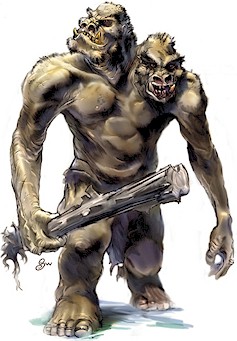Over the course of the semester, we
have reiterated time and time again that a multitude of media we see today is influenced
by medieval literature. From the
connection a hero has with their weapon, to racial depictions of other races,
to religious organizational structure (as seen in A Song of Ice and Fire),
medieval culture’s impact remains on our video games, comics, novels, TV, and
films. However, in noting the various
connections between the medieval period and narrative works today, we have
ignored one of the most notable past times of the modern era. While Gary Gygax’s Dungeon’s and Dragon’s
borrows heavily from a variety of different works in the fantasy genre, many of
the monstrous races seen in works that we have read are directly represented
within the most famous role playing game of all time.
Dungeons and Dragons differentiates from its other media counterparts. Unlike the constricted nature that a linear
story has, the ability of player choice in a Dungeons and Dragons game forces
the game to have a variety of different opponents and obstacles. If confronted by a fork in the road, a
dungeon master (the referee/storyteller) must have each direction prepared with
challenges for the other players to overcome.
As a result, there are a variety of unique monsters in Dungeons and
Dragons.
One unique monster is the
Ettin. The Ettin is a giant like
creature with two heads, each of which is capable of independent thought, and
each controls one arm for attacking. The left head directs the left arm and
right head directs the right arm during combat. The two heads disagree
constantly, but will work together when there is a common threat. On the scale of morality, they are chaotic
evil. While the two headed nature of the
giant is not something we have seen (so far) in our class, we have seen several
instances of giants present, such as Arthur’s encounter with the giants who
collected beards. The ettin is physically
empowering and pure evil. His function
as chaotic evil and powerful stature is similar to the article “Of giants sex
monsters and the middle ages”, where defeating such a worthy opponent gives the
characters (or in this case players) a sense of triumph and accomplishment.
Another medieval monster that is
found in the game is the Tarrasque, a
dragon with a lion's
head, six short legs like a bear's,
an ox-like
body covered with a turtle shell, and a scaly tail that ended in a scorpion's sting . While we have not read the story
in this class, its themes are similar to other Christain converting tales we
have read, such as The King of Tars.
According to legend, the
king of Nerluc had attacked the Tarasque with knights and catapults, but it had no effect. Saint Martha found the beast and charmed it with hymns
and prayers instead of attacking it, and led the tamed Tarasque to the city.
The people, terrified by the monster, attacked it when it came close to them.
The monster offered no resistance and died there. Martha then preached to the
people and converted many of them to Christianity. The townspeople then changed the name of the
town to Tarascon. In Dungeons and
Dragons, the game respects this history, stating that “The tarrasque can be
slain only by raising its nonlethal damage total to its full normal hit points
+10 (or 868 hit points) and using a wish or miracle spell to keep it dead.” Essentially, the only way to kill the tarrasque
is by calling to a divinity, just as Saint Martha called to her Christian god.
One
of the great things about Dungeons and Dragons are the rich influences
of its source material. From Giants to
Tarrasque’s, from swords to practices of the time period, the game functions as
an interesting modern look on a time period that existed a long time ago.



No comments:
Post a Comment